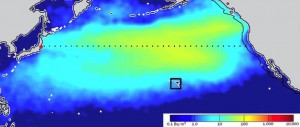Graphics choices depend on audience
From BBC News,in what’s actually a very good story, a picture of radiation from Fukushima spreading across the Pacific.
It’s actually a picture of a model prediction — the story is about using measurements of radiation from Fukushima to decide between two models that give predictions disagreeing by a factor of more than ten. That’s important not for the current plume, but in case there’s serious radiation release into the ocean from some reactor at some time in the future.
My point, though, is about colour scales. The yellow-green colour looks to be about halfway between reassuring non-irradiated dark blue and OMG WE’RE ALL GOING TO DIE!1!11!! dark red. It isn’t. The colour is on a logarithmic scale, so the maximum predicted concentration is about 30 becquerels per cubic metre, and the dark red is 10,000 becquerels per cubic metre. That sounds like a lot, but becquerels are very small — enough radioactive material to have one atom decaying per second. A banana contains about 15 becquerels of potassium-40.
In fact, the story says that 10,000 Bq/m3 , the dark red end of the scale, is the Canadian safety threshold for radiation in drinking water (ie, about 1.5 litres of water per banana of radiation), so the yellow colour on the map is about one third of one percent of the official safety threshold for drinking water.
There’s a good reason the graphic uses a log scale and a very low limit — on a scale that corresponded to risk the predicted Fukushima plume would be completely invisible. For scientific presentation, the graphic and its scaling are completely appropriate. For the top of a story on a mass-media website, perhaps not so much.
(via @zentree)
Thomas Lumley (@tslumley) is Professor of Biostatistics at the University of Auckland. His research interests include semiparametric models, survey sampling, statistical computing, foundations of statistics, and whatever methodological problems his medical collaborators come up with. He also blogs at Biased and Inefficient See all posts by Thomas Lumley »

PS: yes, I do know that the impact of one becquerel depends on the type of radiation, but the story is about cesium-137, which produces a mixture of beta or gamma emission reasonably similar to the potassium-40 in bananas.
11 years ago